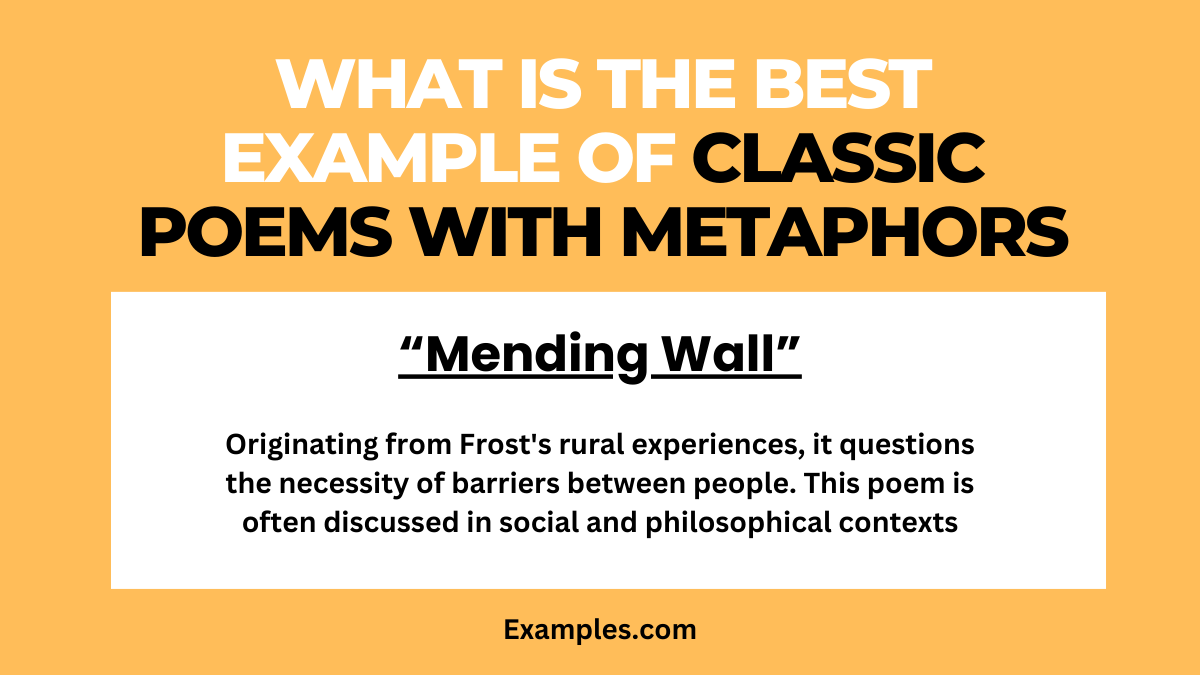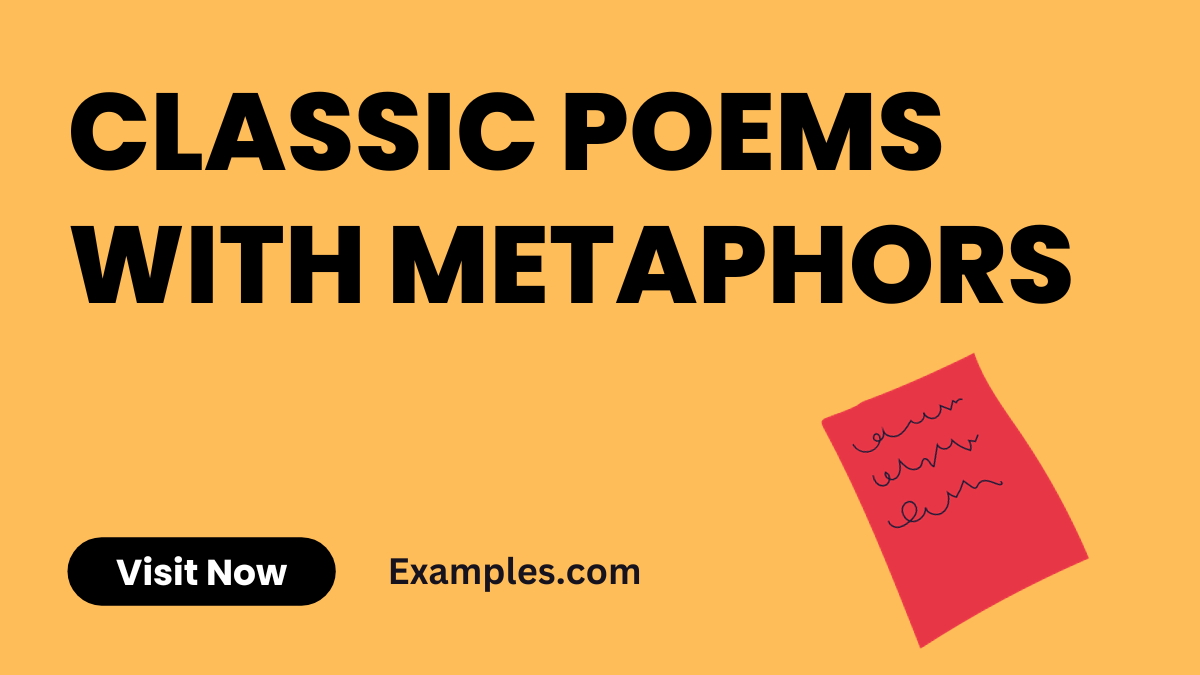6+ Classic Poems with Metaphors Examples
Delve into the realm of Classic Poems with Metaphors, where words transcend their literal meanings to paint vivid imagery and evoke profound emotions. This guide offers a curated selection of timeless poems, each rich in metaphor examples, to illuminate the power of this literary device. Enhance your understanding of metaphors, learn how they shape meaning, and explore their significance in classic poetry. Whether you’re a literature enthusiast or a curious reader, this journey through metaphorical landscapes will enrich your appreciation of poetic expression.
Download Classic Poems with Metaphors PDF
What is the Best Example of Classic Poems with Metaphors

One of the best examples of Classic Poems with Metaphors is “The Road Not Taken” by Robert Frost. This poem masterfully uses the metaphor of a diverging path in a wood to symbolize life’s choices and their consequences. Frost’s poetic brilliance lies in the simplicity yet depth of the metaphor, allowing readers to reflect on their own life decisions and paths. The poem’s universal appeal and its profound metaphorical resonance make it a quintessential example in the study of classic metaphorical poetry.
List of Classic Poems with Metaphors

1. “The Road Not Taken” by Robert Frost
“The Road Not Taken” is a classic poem by Robert Frost, renowned for its profound metaphorical significance. Originating from Frost’s personal experiences, it explores themes of choice, individuality, and the unknown. This poem is widely used in educational settings and personal reflections, symbolizing life’s crossroads. This classic poem serves as a Metaphor Sentence, capturing the essence of life’s choices and crossroads.
Download Full Poem The Road Not Taken PDF
Metaphors:
- “Two roads diverged in a yellow wood” – Opening line: Represents life’s choices and diverging paths.
- “And sorry I could not travel both” – First stanza: Symbolizes the inevitability of making decisions and the impossibility of experiencing all life paths.
- “I took the one less traveled by” – Last stanza: Implies choosing a unique, less conventional path in life.
2. “O Captain! My Captain!” by Walt Whitman
“O Captain! My Captain!” by Walt Whitman, a poignant Metaphor in Literature, uses maritime imagery as an allegory for Abraham Lincoln’s leadership during the American Civil War. written as an elegy for Abraham Lincoln. It uses maritime imagery to convey the nation’s grief and loss at Lincoln’s assassination.
Download Full Poem O Captain My Captain PDF
Metaphors:
- “O Captain! My Captain!” – Throughout the poem: Represents Abraham Lincoln as the leader of the nation.
- “The ship has weather’d every rack” – First stanza: Symbolizes the United States enduring the Civil War.
- “The port is near, the bells I hear” – Second stanza: Indicates the end of the Civil War and a return to peace.
3. “Hope is the Thing with Feathers” by Emily Dickinson
Emily Dickinson’s “Hope is the Thing with Feathers” is an outstanding Simile and Metaphor, where hope is metaphorically portrayed as a bird. This short, yet profound poem, is an ideal Metaphor for Kids due to its simplicity and depth. This poem, originating from Dickinson’s introspective nature, beautifully personifies hope, making it relatable and vivid. It’s popular in therapeutic and motivational contexts for its uplifting imagery.
Download Full Poem Hope is the Thing with Feathers PDF
Metaphors:
- “Hope is the thing with feathers” – Opening line: Likens hope to a bird, suggesting its ability to uplift.
- “That perches in the soul” – First stanza: Implies hope residing within the human spirit.
- “And sings the tune without the words” – First stanza: Represents the ineffable quality of hope.
4. “The New Colossus” by Emma Lazarus
“The New Colossus” by Emma Lazarus is famous for its inscription on the Statue of Liberty. This poem uses metaphor to welcome immigrants to America, portraying the statue as a ‘Mother of Exiles’. It has become a symbol of America’s identity as a land of freedom and opportunity.
Download Full Poem The New Colossus PDF
Metaphors:
- “The Mother of Exiles” – Second stanza: Depicts the Statue of Liberty as a welcoming figure to immigrants.
- “A mighty woman with a torch” – First stanza: Symbolizes guidance and hope for newcomers.
- “Her beacon-hand” – Third stanza: Represents the light of freedom and opportunity.
5. “Mending Wall” by Robert Frost
“Mending Wall” by Robert Frost delves into the metaphor of a wall between neighbors to explore themes of boundaries and human relationships. Originating from Frost’s rural experiences, it questions the necessity of barriers between people. This poem is often discussed in social and philosophical contexts.
Metaphors:
- “Something there is that doesn’t love a wall” – Opening line: Suggests a natural aversion to barriers.
- “Good fences make good neighbors” – Repeated line: Explores the paradox of separation fostering good relations.
- “Bringing a stone grasped firmly by the top” – Throughout the poem: Implies the effort involved in maintaining divisions.
6. “Daffodils” by William Wordsworth
William Wordsworth’s “Daffodils” is a quintessential example of romantic poetry, using vivid metaphors to describe the beauty of nature. It originates from Wordsworth’s love for nature and his Lake District surroundings. The poem is celebrated for its ability to evoke joy and tranquility. For educational purposes, particularly in lower grades like Metaphor Poems for 3rd grade, 4th grade, 5th grade, and 6th grade, Easy Metaphor are essential.
Metaphors:
- “A host, of golden daffodils” – First stanza: Likens a group of flowers to a lively gathering.
- “Fluttering and dancing in the breeze” – Second stanza: Suggests the flowers’ movement is akin to dancing.
- “They stretched in never-ending line” – Third stanza: Depicts the vastness and continuity of nature.
7. “Do Not Go Gentle into That Good Night” by Dylan Thomas
Dylan Thomas’ “Do Not Go Gentle into That Good Night” is a powerful poem using metaphor to discuss life and death. Written during Thomas’ father’s illness, it’s a passionate plea against succumbing quietly to death. This poem is often cited in discussions about aging and the human spirit.
Metaphors:
- “That good night” – Refrain: Represents death.
- “Rage, rage against the dying of the light” – Refrain: Symbolizes fighting against the end of life.
- “Wild men who caught and sang the sun in flight” – Third stanza: Illustrates people who lived passionately.
Short Classic Poems with Metaphors
1. “Hope is the Thing with Feathers” by Emily Dickinson
This short poem by Emily Dickinson, written in the 19th century, uses metaphor to personify hope as a bird. The poem is renowned for its simplicity and depth, illustrating how hope perches in the soul and sings through hardship. It’s widely used in educational and therapeutic settings to inspire resilience.
Metaphors:
- “Feathers”: The poem opens with this metaphor, comparing hope to a bird. It suggests that hope is light and uplifting.
- “sings the tune without the words”: This line suggests that hope is an ineffable, wordless feeling that continues despite challenges.
- “never stops at all”: This metaphor implies the enduring, persistent nature of hope, even in the toughest times.
2. “The Fog” by Carl Sandburg
Written by Carl Sandburg in the early 20th century, “The Fog” uses a simple yet powerful metaphor to describe the fog’s arrival and departure. The poem is celebrated for its imagery and is often used in literature classes to teach metaphorical writing.
Metaphors
- “The fog comes on little cat feet”: This line compares the fog’s quiet, stealthy approach to a cat’s gentle footsteps.
- “It sits looking over harbor and city”: The fog is personified as a sentient being observing its surroundings, enhancing the imagery.
- “moves on”: The departure of the fog is likened to a quiet, unobtrusive movement, maintaining the cat-like imagery.
3. “Fire and Ice” by Robert Frost
“Fire and Ice” by Robert Frost explores the themes of desire and hatred through powerful metaphors. Written in the 1920s, the poem reflects on the destructive powers of human emotions and is popular in academic and philosophical discussions.
Metaphors
- “Fire”: Represents desire and passion, suggesting their potential to cause destruction.
- “Ice”: Symbolizes hate and indifference, indicating another form of destruction.
- “world will end”: This metaphor serves as a commentary on the potential self-destructiveness of human emotions.
Classic Poems with Metaphors for Students
1. “The Road Not Taken” by Robert Frost
This poem, one of Frost’s most famous works, uses the metaphor of a road to represent life’s choices. Written in 1916, it’s a staple in educational curriculums for its themes of individuality and decision-making.
Metaphors
- “Two roads diverged in a yellow wood”: Represents life’s choices and the necessity to make decisions.
- “One less traveled by”: Symbolizes the unconventional, less chosen path in life.
- “And that has made all the difference”: Implies the significant impact of choices on one’s life journey.
2. “O Captain! My Captain!” by Walt Whitman
Written as a metaphorical elegy for Abraham Lincoln, Whitman’s poem uses the metaphor of a ship and its captain to depict the end of the Civil War and Lincoln’s assassination. It’s widely taught in schools for its historical and poetic significance.
Metaphors
- “Ship”: Represents the United States during the Civil War.
- “Captain”: Symbolizes Abraham Lincoln as the leader.
- “Voyage closed and done”: Reflects the end of the Civil War and the success of the Union.
3. “Mending Wall” by Robert Frost
This poem uses the metaphor of a stone wall to explore themes of boundaries and relationships. Written in 1914, it’s a favorite in school curriculums for discussing the complexities of human interaction.
Metaphors
- “Good fences make good neighbors”: Explores the idea that boundaries can maintain peaceful relationships.
- “Wall”: Represents physical and metaphorical barriers between people.
- “Something there is that doesn’t love a wall”: Suggests a natural resistance to barriers and the desire for openness.
Classic Poems with Metaphors about Life
1. “Stopping by Woods on a Snowy Evening” by Robert Frost
This poem, written by Frost in 1922, uses the metaphor of a snowy evening to depict life’s journey and the allure of rest versus responsibilities. It’s popular in discussions on life’s contemplations and choices. This concept is also prevalent in Metaphor Poems about Dog and Metaphor Poems about Flowers, where these elements symbolize family aspects.
Metaphors
- “Woods”: Symbolizes the mysterious, unknown aspects of life.
- “Snowy evening”: Represents the peaceful yet seductive allure of ceasing one’s duties.
- “Miles to go before I sleep”: Indicates life’s ongoing responsibilities and journeys.
2. “Sonnet 18” by William Shakespeare
One of Shakespeare’s most beloved sonnets, “Sonnet 18” uses metaphors to compare a loved one to a summer’s day, exploring themes of beauty and immortality. It’s a classic example of metaphor in poetic love expressions. Metaphor in Romeo and Juliet, Shakespeare’s use of metaphorical language to convey deep emotions and vivid imagery stands out, another Popular Metaphor where he compares a loved one to a summer’s day
Metaphors
- “Summer’s day”: Represents the beauty and warmth of the loved one.
- “Eternal lines to time”: Suggests the enduring nature of written word and love.
- “Nor shall Death brag”: Personifies death, implying that true beauty and love transcend mortality.
3. “The Love Song of J. Alfred Prufrock” by T.S. Eliot
T.S. Eliot’s modernist poem employs a stream of consciousness style with rich metaphors to explore life’s insecurities and the passage of time. It’s esteemed in literary circles for its depth and complexity.
Metaphors
- “Evenings, mornings, afternoons”: Symbolizes the mundane passage of time in life.
- “Measured out my life with coffee spoons”: Represents life’s repetitive, trivial routines.
- “Drowned a mermaid”: Implies the loss of fantastical, unattainable dreams.
Classic Poems with Metaphors offer a profound window into the human experience, encapsulating life’s complexities, emotions, and journeys. These Best metaphor Poems examples, rich in metaphorical depth, serve as a complete guide to understanding and appreciating the timeless beauty and power of metaphor in poetry.


